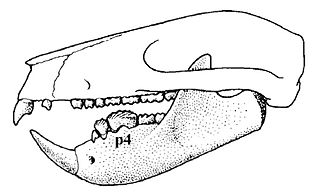
Plagiaulax is a genus of mammal from the Lower Cretaceous of Europe. It was a member of the also extinct order Multituberculata, and shared the world with dinosaurs. It is of the suborder "Plagiaulacida" and family Plagiaulacidae. The genus was named by Hugh Falconer in 1857, and was the first described multituberculate species.
Eutropis dawsoni, also known commonly as Gans's grass skink and Gans's mabuya, is a species of lizard in the family Scincidae. The species is endemic to the southern Western Ghats, India.
The New Zealand catshark is a catshark of the family Scyliorhinidae in the order Carcharhiniformes. This species is endemic to in the deep waters around New Zealand. Its length is up to 45 centimetres (18 in). The New Zealand catshark is a small, little-known deep water bottom shark. It is dark brown around the top with a few widely spaced pale spots, and white below. It feeds on bottom-living crustaceans. It is also completely harmless to humans.

The Queen Charlotte Islands caribou or Dawson's caribou is an extinct subspecies of the Arctic caribou that once lived on Graham Island, the largest of the islands of Haida Gwaii in British Columbia, Canada. Possible causes of its extinction include habitat destruction, introduced disease and overhunting. It was grey in appearance. The last three caribou were killed in 1908 and can be seen at the Royal British Columbia Museum, where their pelts and bones are preserved and displayed. Recent analysis of mtDNA suggests that the Queen Charlotte Islands caribou was not genetically distinct from the subspecies from the Canadian mainland.
Aegialodon dawsoni is an extinct mammal from the early Cretaceous, known from fossilised teeth discovered in the Wadhurst Clay Formation near Cliff End, Hastings, East Sussex.
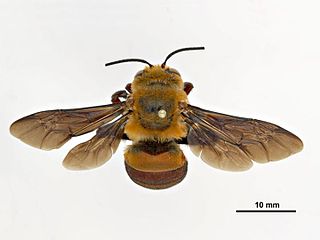
Amegilla dawsoni, sometimes called the Dawson's burrowing bee, is a species of bee that nests by the thousands in arid claypans in Western Australia. It is a long tongued bee, of the tribe Anthophorini and genus Amegilla, the second largest genus in Anthophorini.

Syngnathus dawsoni is a species of the pipefishes. It occurs in the central, western Atlantic in the Caribbean Sea from Puerto Rico to St. Lucia and has been recorded only from the east of the Mona Passage. It is a marine tropical demersal fish. It is ovoviviparous; the male carries the fertilized eggs in a brood pouch located under his tail. It has been captured at around 7 metres (23 ft) in shallow, inshore water but its habits and ecology are unknown. The specific name honours Charles Eric Dawson who collected the type material and who recognised this species as different from the other Atlantic members of the family Syngnathidae.
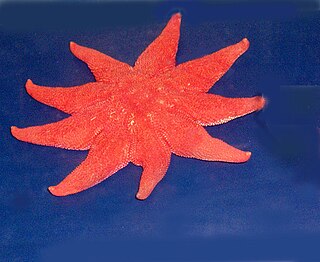
Solaster is a genus of sea stars in the family Solasteridae.

Solaster dawsoni, the morning sun star, is a species of starfish in the family Solasteridae. It is found on either side of the northern Pacific Ocean. It has two subspecies:

Rhytiphora is a genus of flat-faced longhorn beetles in the Pteropliini tribe of the subfamily Lamiinae. The genus was first described in 1835 by Jean Guillaume Audinet-Serville.

Charles Eric "Chuck" Dawson Jr. was a Canadian-American ecologist, ichthyologist, and taxonomist. He held expertise in gobies, flatfishes, and sand stargazers, and was considered "the ultimate authority" on pipefishes in the family Syngnathidae.
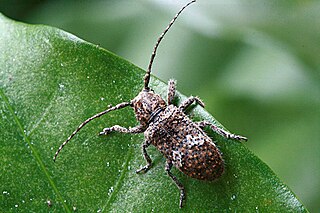
Rhytiphora bankii is a species of beetle in the family Cerambycidae. It was first described by Johan Christian Fabricius in 1775, under the genus Lamia. It is known from Australia, the Philippines, Borneo, Java, Micronesia, New Guinea, Hawaii, Moluccas, Sumatra, Vietnam, and has been introduced into Japan. The Australian species of Prosoplus were synonymised with Rhytiphora in 2013.
Rhytiphora viridescens is a species of beetle in the family Cerambycidae. It was described by Stephan von Breuning in 1938. It is known from Australia.
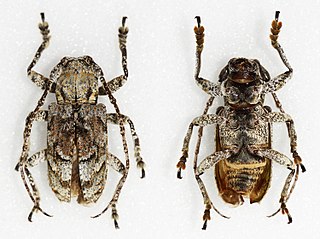
Rhytiphora maculicornis is a species of beetle in the family Cerambycidae. It was described by Francis Polkinghorne Pascoe in 1858. It is from Australia.
Rhytiphora saundersi is a species of beetle in the family Cerambycidae. It was described by Francis Polkinghorne Pascoe in 1857. It is known from Australia. It contains the varietas Rhytiphora saundersi var. spenceri.
Rhytiphora argus is a species of beetle in the family Cerambycidae. It was described by Francis Polkinghorne Pascoe in 1867. It is known from Australia.
Rhytiphora sospitalis is a species of beetle in the family Cerambycidae. It was described by Francis Polkinghorne Pascoe in 1865. It is known from Australia.
Rhytiphora albocincta is a species of beetle in the family Cerambycidae. It was described by Félix Édouard Guérin-Méneville in 1831, originally under the genus Saperda. It is known from Australia. It feeds on Acacia pubescens and Acacia longifolia. It contains the variety Rhytiphora albocincta var. compos.
Melanoplus dawsoni, or Dawson's grasshopper, is a species of spur-throated grasshopper in the family Acrididae. It is found in North America.









